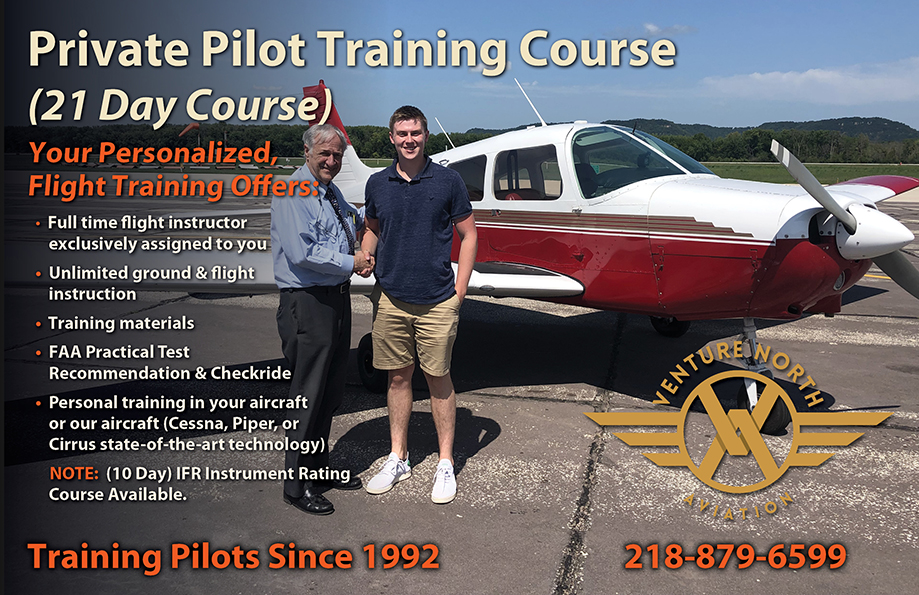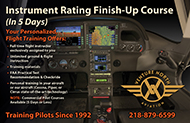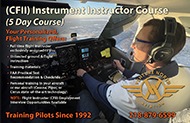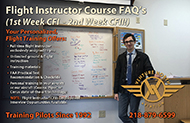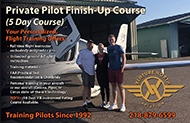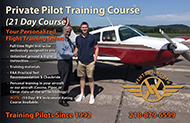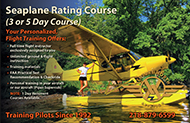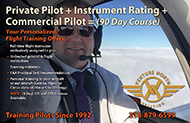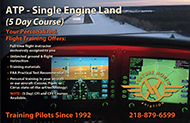Complete Private Pilot Course (21 Days)
Our Complete 21 Day Accelerated Private Pilot Course is an upscale program designed to immerse the Student Pilot into a dedicated complete private pilot training program. Our accelerated training focuses on Single Pilot Operations and Scenario Based Training.
Train the way you Fly - Fly the way you train
The 21st day includes the Private Pilot practical test with an FAA Designated Pilot Examiner.
21 Day Private Pilot Course Includes:
- Flight Instructor Exclusively Assigned to You
- Unlimited Instruction
- Training Materials
- FAA Written Test Ground School Training & Preperation
- FAA Practical Test Recommendation & Check Ride
- Call for pricing - (in your plane)
- Call for pricing - (in our plane) Cirrus SR22 G3 Perspective/ GPS WAAS or Cirrus SR22 Avidyne / GPS Garmin 430 WAAS or CE-172RG / GPS Garmin 430 WAAS or PA-28-151 Piper Warrior with GPS Garmin 430 WAAS
- Note: Course, pricing, flight and ground instruction can be customized to individual needs
- Note: Includes average 45 hours of flight instruction.
- Note: Hotel & housing available
- Note: Courtesy vehicle transporation available
- Note: Train at our location or we can train at your location anywhere in the US
- Contact Us At: 218-879-6599 for Course Scheduling
21 Day Private Pilot Course Prerequisites:
For pilots seeking an accelerated private pilot course; come prepared with the following information.
- Current US Passport, or Birth Certificate & Government Issued ID
- Basic Med or FAA Third Class Medical or better with Student Pilot CertificateBe able to read, speak, write and understand the English Language (14-CFR part 61.103 (c))
- No specified minimum age to begin dual flight training. Must be 16 years of age to solo, 17 years of age to take the Practical Exam for the license.
21 Day Private Pilot Training Topics Include:
- Basic aerodynamics and the principles of flight
- Safe and efficient operation of aircraft
- Weight and balance computations
- Use of performance charts
- Significance and effects of exceeding aircraft performance limitations
- Use of aeronautical charts and a magnetic compass for pilotage and dead reckoning
- Use of air navigation facilities
- Aeronautical decision making and judgment
- Principles and functions of aircraft systems
- Maneuvers, procedures, and emergency operations appropriate to the aircraft
- Night operations
- Procedures for operating within the National Airspace System
- Risk Management
- Aeronautical Decision Making
- Task Management
- Single Pilot Resource Management
- Scenario Based Training
- Emergency Operations
- Flight Planning
- Proper power settings and airspeed control
- Applicable FAR's, AIM and Advisory Circulars
- Radio Communications Procedures
- Recognition of critical weather situations from the ground and in flight, windshear avoidance, and the procurement and use of aeronautical weather reports and forecasts
- Safe and efficient operation of aircraft, including collision avoidance, and recognition and avoidance of wake turbulence
- Effects of density altitude on takeoff and climb performance
- Stall awareness, spin entry, spins, and spin recovery techniques for the airplane
- Preflight action that includes—How to obtain information on runway lengths at airports of intended use, data on takeoff and landing distances, weather reports and forecasts, and fuel requirements
- How to plan for alternatives if the planned flight cannot be completed or delays are encountered.

Accelerated Flight Training
- 10 Day Instrument Rating Course
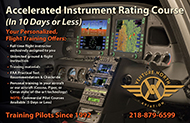
- 5 Day Instrument Rating - Finish Up
- 5 Day Commercial Pilot Course
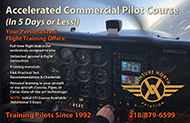
- 5 Day Initial Flight Instructor (CFI) Course
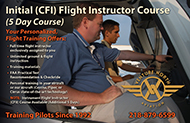
- 5 Day Instrument Flight Instructor (CFII) Course


